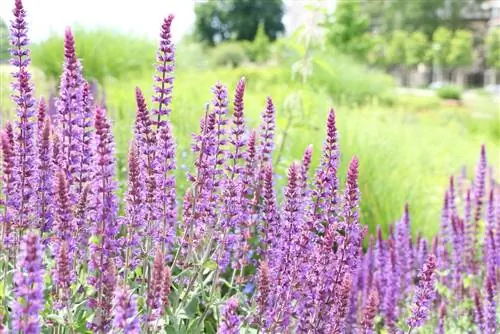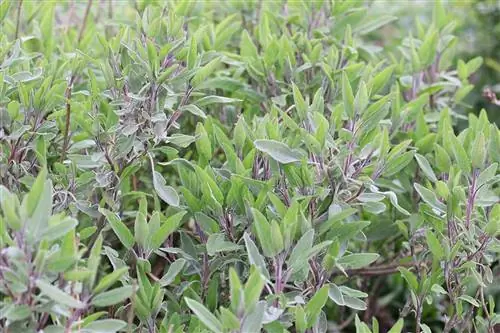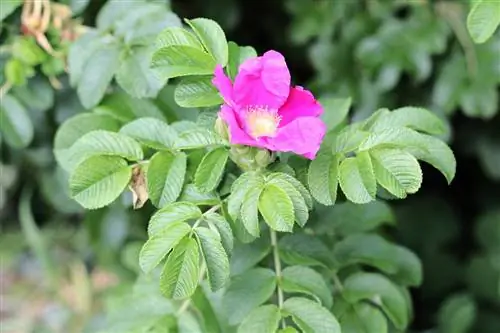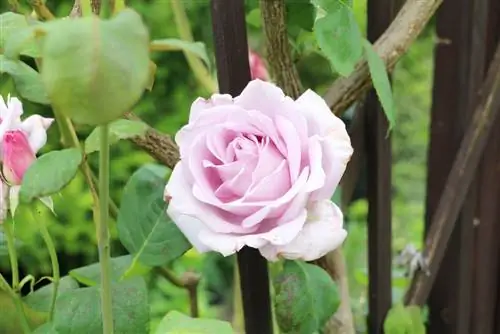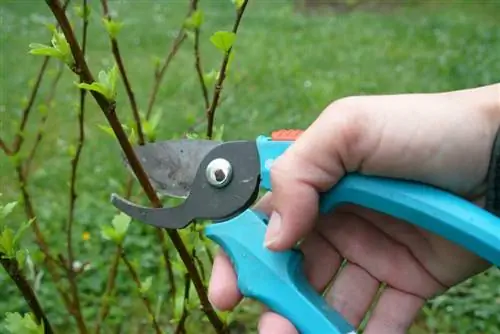- Author admin [email protected].
- Public 2023-12-17 03:39.
- Last modified 2025-01-24 12:45.
The grove sage (Salvia nemorosa) belongs to the genus Salvia, the mint family (Lamiaceae). New breeds are available commercially every year. These include low and taller growing varieties, from 20 to 80 cm. The evergreen steppe sage spreads its Mediterranean flair both outdoors and in pots. As a bee pasture and butterfly magnet, it is an enrichment for nature. There is also a large selection of colors, the shades range from blue, violet and pink to a pure white flower.
Location
Steppe sage is at home in temperate climate zones. It's best to give it a sunny, warm, wind-protected location. It copes well with drought. With waterlogging and shade, not so much. It feels particularly comfortable in the company of other herbaceous shrubs, in rock gardens or gravel beds. The plants surrounding it should not tower over it, because then it will no longer receive enough sun. Partially shaded places are also possible for some varieties, but the flowers may not be as lush.
Floor
The soil for the grove sage should be permeable and rather calcareous. Heavy clay soils that tend to be damp are unsuitable. Such soils must be specially prepared for sage. To do this, the soil is first thoroughly mixed with inorganic materials such as sand, gravel or expanded clay. For planting in containers, you use normal potting soil, which you first enrich with a little sand. It is important to have a good drainage layer in the pot, because here too there should be no waterlogging.
Watering and fertilizing
If the grove sage feels comfortable in its location, further care is child's play. Regular, not excessive, watering during flowering and one or two fertilizer applications per year are sufficient. Compost, complete fertilizer or perennial fertilizer are suitable for fertilization. Fertilize in the spring before flowering. If you like, you can fertilize again for the second flowering in July. Beforehand, you should prune the faded perennial to encourage a second flowering.
Cut

Twice a year you can tackle the grove sage with secateurs: during maintenance pruning in spring and when pruning (removal pruning) in summer. It is best not to prune in the fall after the last flowering; the old herb protects the perennial from winter frost.
Conservation cut
The main pruning then takes place in spring. Here you can cut the perennial generously into shape. Thanks to this measure, the clumps maintain a beautifully compact growth habit. Old, unsightly stems and leaves are removed. The cut can be made up to 15 cm above the ground. You should not cut into the old wood.
removal cut
The second cut takes place after the first flowering. This pruning usually encourages the grove sage to produce a second beautiful flower that lasts until autumn. This measure involves cutting back to around a third. The second flower is not quite as lush as the main flower.
Tip:
It is best to carry out the repair pruning immediately after flowering, as soon as the flowers become limp. This prevents the plant from having to expend unnecessary energy on planting the seeds.
Flower cutting
If you have not carried out any repair pruning, you can gradually remove the faded inflorescences. This also promotes a longer flowering period. It also looks nicer and prevents uncontrolled self-seeding.
Wintering
When it comes to winter hardiness, there are sometimes big differences between the different varieties of Salvia nemorosa. They are generally considered hardy down to -25°C. However, since these are all heat-loving plants, a thin layer of brushwood is almost always advisable to protect against excessive, especially bare, frosts.
Tip:
Horway sage in pots should definitely overwinter in a cool, frost-free place.
Propagate
Basically, sage plants can be propagated by sowing, cuttings and dividing. You can start sowing in a warm place in March. When the first plant leaves appear, they can be separated and then released outdoors from May onwards. Propagation via cuttings is most common in gardening. To do this, slightly harder, but not woody, shoots about 15 cm long are cut off. Then they are placed in potting soil with high humidity. The first roots appear after approx. 4 weeks.
The perennial varieties of Salvia nemorosa become noticeably older and less flowery over the years. Depending on the variety, this can be the case after 3-4 years. Rejuvenation and propagation through division is then easy to carry out. To do this, the plant is dug up in early autumn and the roots are carefully removed from the soil. With a clean cut you divide the root ball and both parts of the plant can be put back in their intended locations.
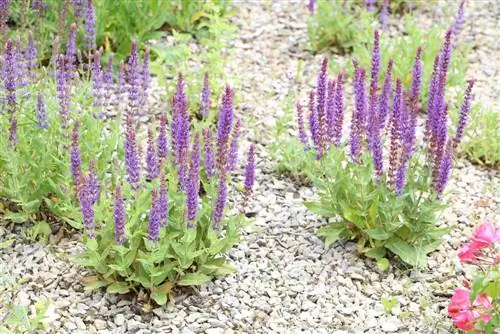
Tip:
It is recommended to divide perennial garden sage regularly, every three years. This measure will keep your sage plant young for many years.
Plants
The sage perennials that are available in garden shops can be planted in the bed almost all of the frost-free year. The requirements for location and soil must be taken into account. Many varieties are also available in seed bags. As a rule, growing your own plants works quite well.
Diseases and pests
A pleasant chapter: There is hardly any significant damage to grove sage caused by diseases or pest infestation. Spider mites or mildew can appear from time to time. If so, then the plants in the pot are more likely to be affected. This can be easily combated with the usual, natural remedies:
- shower mechanically with a hard jet of water
- spray with a mixture of water, soft soap and spirits (30 ml per 1 liter of water)
- spray with a fresh milk-water solution, 1:9 (mildew)
Varieties
The following is a small selection of beautiful Salvia nemorosa varieties:
- 'Viola': deep dark blue flower, blooms early, approx. 40 cm high
- 'Plumosa': blooms purple-violet, flowers densely filled, approx. 40 cm high
- 'Marcus': flowers dark purple, dwarf variety, up to 25 cm high
- 'Caradonna': flowers dark blue, stems are black-violet, approx. 80 cm high
- 'Amethyst': flowers pink-violet, grows tightly upright, approx. 80 cm high
- 'Blue Hill': flowers medium blue, very dense, approx. 30 cm high
- 'Ostfriesland': blooms deep purple, very robust and hardy, up to 50 cm high
- 'Adrian': flowers white and numerous, up to 60 cm high
Plant neighbors
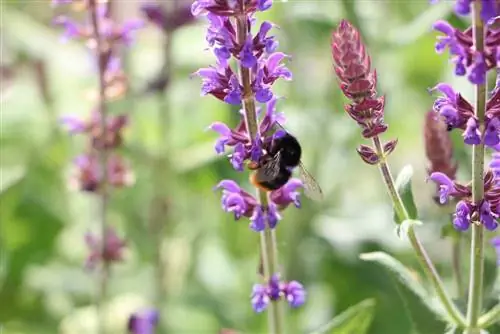
The steppe sage is a sociable plant in beds and borders. The best neighbors are plants with the same soil requirements. They must not grow too high so that they do not deprive the sage of the sun. Good neighbors are for example:
- Gypsophila (Gypsophila repens)
- low garden evening primrose (Oenothera tetragona)
- Pearl Basket (Anaphalis)
- Dark chamomile (Anthemis tinctoria)
- Girl's Eye (Coreopsis)
- Daylilies (Hemerocallis)
- Goldenrod (Solidago)
- low coneflower (Rudbeckia 'Goldsturm')
- Roses
- Heather herbs
- various grasses (e.g. blue fescue)
Conclusion
The robust and long-flowering perennials of Salvia nemorosa can be used to create impressive accents in farm or natural gardens. Smaller varieties are also suitable for border planting. The less winter-hardy sage varieties are well kept in pots. Even if the steppe sage cannot be used in the kitchen, the insects will definitely be happy about the colorful delicacies in the bed.

